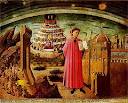La Divina Commedia, De Monarchia
Date: 1318, 1497, 1559, 1581
Region: Europe
Subject: Religious
Medium: Literature
Artist: Dante, Alighieri (1265-1321)
Confronting Bodies: Ruling King, Savonarola, Pope Paul IV, The Index of Trent, The Inquisition.
Dates of Actions: 1318, 1497, 1559, 1581
Location: France, Italy, Portugal
Description of Artwork: "La Divina Commedia," 1302-1321
Three books: "Hell," "Purgatory," "Paradise"; Vast fresco depicting Dante's sorrows and hopes, his fierce hatreds and his cherished beliefs. He affirmed in poetic terms his ethical and political conception of the world and of the ends and duties of man within the twofold order of nature and grace. "De Monarchia," 1310-1313
Treatise of political philosophy in Latin and arranged in three books composed in the years immediately following the arrival of Henry VII in Italy. The Empire was necessary to the well being of the world and the last book considered whether the Emperor was subject to the Pope, or autonomous of the Pope in the secular realm.
The Incident: 1318 France-Lombardy: "De Monarchia" was publicly burned. 1559 Italy-Rome: "De Monarchia" banned by Pope Paul IV and the Index of Trent for asserting that the authority of Kings was derived from God, not through God's Vicar on earth, the Pope. 1581 Portugal-Lisbon: "La Divina Commedia" prohibited by Church authorities.
Results of Incident: 1497 Italy-Florence: Works burned by Savonarola in the "Bonfire of the vanities". 1581 Portugal-Lisbon: "La Divina Commedia" prohibited until all copies were delivered to the Inquisition for correction.
Source: Banned Books 387 B.C. to 1978 A.D., by Anne Lyon Haight, and Chandler B. Grannis, R.R. Bowker Co, 1978.

